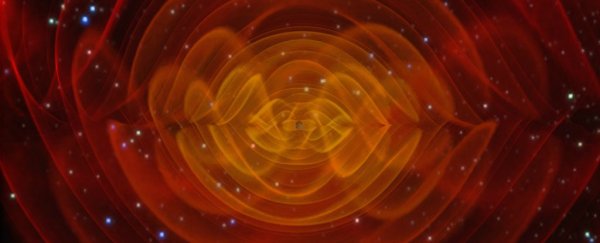Researchers have proposed a method for detecting exotic events in physics by looking for the scars they leave behind on the fabric of space.
By identifying how objects like cosmic strings or evaporating black holes leave behind memories of their existence on the Universe, it might be possible to move some rather strange phenomena from theoretical to empirical science.
It all comes down to an effect of general relativity called gravitational-wave memory, which is the distortion left behind as space is stretched and relaxed by a massive object.
According to general relativity, technically anything with mass can cause the virtual emptiness of space to distort around it.
Some interactions between objects, such as pairs of super-massive objects whirling around one another, can throw off waves in space at the speed of light.
In 2015, scientists watched the interference patterns of lasers at the Laser Interferometer Gravitational-Wave Observatory (LIGO) to observe this subtle push-and-pull of space wash over us for the first time.
It took the shock of a pair of black holes – each about 30 times the mass of our Sun – accelerating to half of the speed of light before smashing together, to create those gravitational-waves.
Even with such energy, by the time those waves hit our planet some 1.3 billion years later, the total distortion of space was on the scale of a proton, and lasted just 0.2 seconds.
Yet after they danced around, tugging on the very fabric of the Universe, space wasn't left quite as they found it.
"[W]e can think of two astronauts floating in free space," researcher Paul Lasky from Monash University in Australia told ScienceAlert.
"When a gravitational-wave memory signal passes between those two astronauts, there is a permanent change in the distance between them – the space-time between them has either stretched or squeezed."
The underlying signature of that permanent distortion – called a gravitational-wave memory – wouldn't be easy to spot. For something like the 2015 black hole collision spotted by LIGO, the signature frequency of the memory wave might be detectable only with the recording of a large number of similar events to build a clear picture.
Yet according to this new research by Lasky and his Monash colleagues Lucy McNeill and Eric Thrane, we should consider the possibility of some events producing higher frequency memory waves which could technically be more easily observed.
"Our paper points out that, if gravitational waves are emitted with such a high frequency that LIGO cannot observe them, there is still a chance that LIGO can observe the memory part of the signal," said Lasky.
Nicknamed 'orphans' due to the fact their parent wave wouldn't be directly detectable, these waves could open the way for studying physics currently inaccessible to our technology.
A lot of weird and wonderful objects have been speculated to produce high frequency gravitational waves, from primordial black holes to tiny one dimensional defects in space called cosmic strings.
Until we have some way to observe the signatures such things might leave behind, however, they'll have to stay purely theoretical.
"It is worth pointing out that, at the moment, these are quite speculative sources of gravitational waves. But of course, that's part of the excitement of it. If we detect one of these sources, then it would be a truly exciting moment," Lasky told ScienceAlert.
Since the detection of orphans doesn't require any big developments in technology, it's feasible we could start using LIGO to hunt for them now.
"We can predict what that signal should look like for an orphan memory signal, although we have no idea when it will arrive," said Lasky.
There's no doubt our ability to detect gravitational waves will continue to unveil many of the Universe's secrets.
LIGO is already being considered as a way to detect theoretical particles called axions, or locating extra dimensions.
We shouldn't hold our breath, but who knows what new discoveries future versions of LIGO might produce?
This research was published in Physical Letter Reviews.
